Why You Should Create a Mobile Learning Platform
Mobile phones are quickly replacing many items that were previously thought to be irreplaceable. Consider, for example; cameras, calculators, watches, alarm clocks, radios, portable video devices, magazines, newspapers, etc. All of these items can now be stored on your mobile device – comfortably resting in your pocket.
Today, a large number of users have also switched from reading printed documents, to reading digitized content through mobile devices, whether they’re reading fiction, non-fiction, short stories, etc. A growing trend in recent years, is the utilization of mobile-based learning. This incorporates everything from fully-fledged and heavily sponsored library apps, to standalone MOOC software, to educational game apps and individual course hosting.

People are shifting towards doing everything they can while on-the-go. In many ways, they can be encouraged to even study and learn through their phones. Mobile learning is definitely on the rise, and in this article we explore the pros and cons of mobile learning while also offering our own insight to establishing your mobile learning strategy, along with a handful of tools you can utilize to start creating your own mobile learning platform.
Pros of creating a mobile learning platform
- Portability: Lessons, videos, models, books and libraries can be easily accessed from anywhere.
- Creating courses that maintain flexible learning hours is a big advantage for many learners as they can access the platform anytime. This way, learners can follow the course at their own pace, racing ahead where they don’t feel challenged while revisiting some harder-to-digest modules.
- Due to the constant evolution of mobile devices, new tools are constantly surfacing that can be exploited to offer a rich and dynamic learning experience.
- Modules can be completed offline by learners. Their progress information would be sent back to your LMS when they’re back online again.
- The large variety of mobile devices creates a pool of opportunity and innovation, allowing people to quickly and easily access digital information.
- Easily allows room for gamification, this can create high levels of engagement for younger generations.
Cons of creating a mobile learning platform
- You’ll be targeting learners who are on-the-go. They’ll be constantly getting distracted and won’t be able to commit long periods of time to your platform.
- Trying to study while stooping over a small screen can be frustrating for many learners.
- Storage capacities of mobile devices are incomparable to that of desktops and laptops.
- While smart phones are insanely popular, there is a very small percentage of users currently using their phones to access learning platforms and activities (we’d consider this more of an opportunity for the future, while causing a challenge today).
- Many organizations aren’t ready to accept mobile learning, yet. Sticking strongly with traditional classroom-based education led by the instructor may work for today, but let’s hope that changes soon.
- Short battery life and highly-consuming apps is always a pain for learners.
Establishing your mobile learning strategy
Identify your learners
You need to know as much as you possibly can about your target audience. Aside from their general demographics, you’d also need to discover as much as possible about their mobile usage habits and their current educational needs.

Utilize mobile survey software to collect relevant information; conduct surveys and focus groups to learn things like how often your audience uses their mobile devices, what they’re looking to take away from their mobile learning experience. Also ask them how far are they willing to indulge in mobile learning? How much time will they be able to dedicate to this activity?
Consider your learning material
Next, you need to consider your learning material. Use the target audience information you’ve gathered to determine the type of course that you’ll be developing or adapting to your mobile learning interface.
- One way to go is traditional elearning courses comprising of text chapters accompanied by pictures and the occasional explanatory video, animation or chart. This type of course would also include tests, assignments, etc.
- However, if the opportunity for creativity presents itself, and you feel your audience would respond well to it, consider using more interactive solutions. You can try gamification of your course material, this would work well as learners on the go would need a solid attraction that would allow for some distraction. Maybe video classes or interactive infographics would work best for your learners. Follow the links above for examples.
Remember that you’re dealing with a distractible audience. So you must create highly-engaging, information-packed content. From start to end, they should feel they can’t put their phone down until they get your whole message. Hold their attention by constantly providing integral knowledge with real-life implications and benefits they can relate to.
At this point, you’ll also need to decide on your success metrics. Do you want learners to achieve a certain score to show understanding of the course? Do you want to increase the number of studies they publish? Perhaps an increase in the number of extra-curricular activities they participate in. Whatever your educational goals are, develop ways to measure whether your learners have achieved them.
Are you looking for elearning templates? Check out this gigantic collection of free templates offered by eLearningDom.com
Decide your platform’s compatibility
At this stage of your strategy, you’ll need to decide which operating systems and mobile platforms will be able to support and access the material. You’ll have to decide whether your course will be exclusive to a certain operating system, such as iOS, Android or Windows Phone. Or if you’ll make it accessible on all of them, to reach a wider audience.
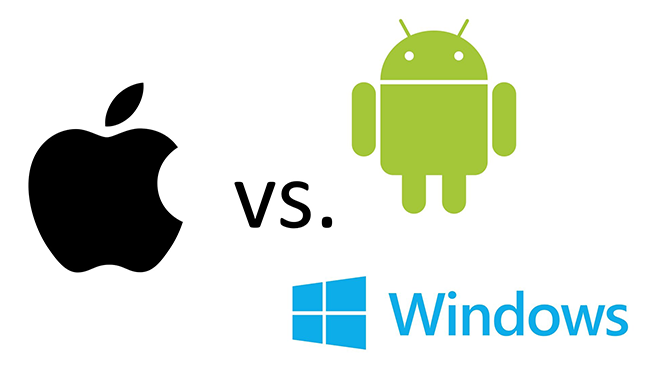
Another important consideration is whether it will be a native app that can be downloaded directly from the App Store or Play Store, etc. or if it’ll be better to host as a web-based HTML5 website that is mobile-friendly and responsive.
Let’s explain these two points a bit more, shall we?
- A native app sits comfortably on your phone just like any other app. It’s readily accessible and can be easily downloaded from the app stores. If you’re looking to get more creative, you can design the app material in a way that needs to utilizes specific internal features such as geolocation, gyroscope, compass, etc. The problem would be that you’d need to create an individual app for each operating platform.
- A web-based HTML5 website with a responsive mobile view would be accessible by almost all mobile devices. The best part about it is that you’d create one version that would run on different operating systems. The worst part is that learners would need to be constantly connected to the internet.
Important considerations for your mobile learning platform
Refurbish your current content to make it suitable for mobile devices
There’s no need to start from scratch. Most of your current elearning courses can be repurposed and redesigned to fit on most mobile devices comfortably. However, it’s important to make your mobile version of the content as easy to absorb as possible. Don’t ignore the fact that the majority of your learners won’t have the time and ability to sit down and focus for more than 10-15 minutes at a time. Make your content bite-sized, helpfully highlight the most important points, break down long text content to lists and bullet points, or flash cards.
Use tracking data to fine tune the mobile learning experience
If you’re using a SCORM-compliant learning tool or a tool that supports book analytics, such as Kotobee Author, you can constantly reassess the relevance, interface and experience of your mobile learning platform.
For example, if you discover a certain video is being ignored, you can place it somewhere else with higher visibility. If learners are viewing part of the video but not completing it, consider editing its contents or scratch it entirely. If only a handful of learners are completing a certain course, maybe it’s too difficult. However, if a certain course is doing really well, you should design supporting content and follow-up courses to your more popular content.

Using tracking data will ultimately help you create content that is rich and valuable by constantly reassessing how learners are reacting to your content.
Learn how to track ebook data using Kotobee by reading this article:
Viewing ebook analytics using Google Analytics
Mobile learning should be complementary, not exclusive
At this stage of digital learning, creating elearning modules that are exclusive to mobile devices would, generally, be a bad idea. It’s meant as a complementary platform to fit in with your existing channels of elearning.
For starters, not all of your audience would be ready to stick to a mobile learning experience. Many may even refuse to try it. You’ll need to ease your readers, perhaps by encouraging them to complete extra courses for extra credit, and the extra courses just happen to be available on mobile phones. That way, your more enthusiastic followers would discover, first-hand, the uniqueness of your mobile learning platform.
Using Kotobee to create your mobile learning platform
Kotobee is a comprehensive suite capable of helping you achieve your mobile learning goals. If you’re considering creating a mobile learning platform, there are several ways Kotobee can help you achieve that.
The terms ebook and book app, for the following three points, are being used loosely. You see, as you have full control over the code of your document, and with the amazing abilities of HTML5, you can turn ebooks to almost anything you can imagine. This includes self-assessment questions, case-studies, exercises, CYOA (Choose Your Own Adventure) mini-games, trivia quiz games, video classes and so on. Your limit is the boundaries of your creativity.
Creating interactive book apps available on the app stores
Kotobee Author allows you to export your ebook as a standalone app that can then be published on Apple’s App Store or Google’s Play Store. All you’d need to do is create your ebook just like you would normally, just bear in mind your learners’ average screen dimensions, then you have the option to export your ebook as IPA (Apple), APK (Android) or XAP (Windows Phone) file.
You can read more about exporting native mobile apps through Kotobee Author from this support article: Exporting mobile apps
An obvious advantage here is that your book app can be made available for free or for a price. Also, you can enable ads through the Google Admob platform. That way you’ll be getting paid by Google for clicks and impressions on ads provided through them.
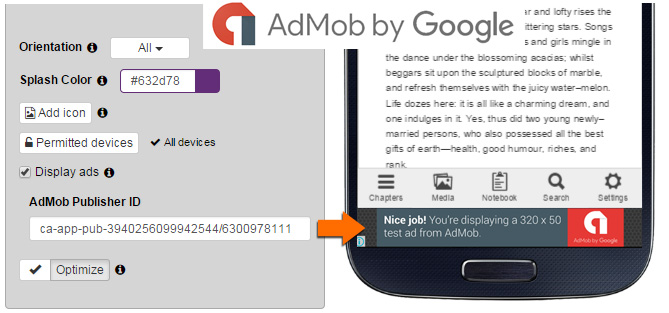
You can find more information on Admob in this article: Great new features in Kotobee Author v1.3.0
Now you can publish your platform to any of these stores. Just bear in mind that each has a different publishing process.
Creating individual ebooks to be hosted online with restricted access
Kotobee Cloud allows you to host your created ebook to our servers, you can designate a password for each ebook, issue coupon codes, add/remove or edit users, and more.
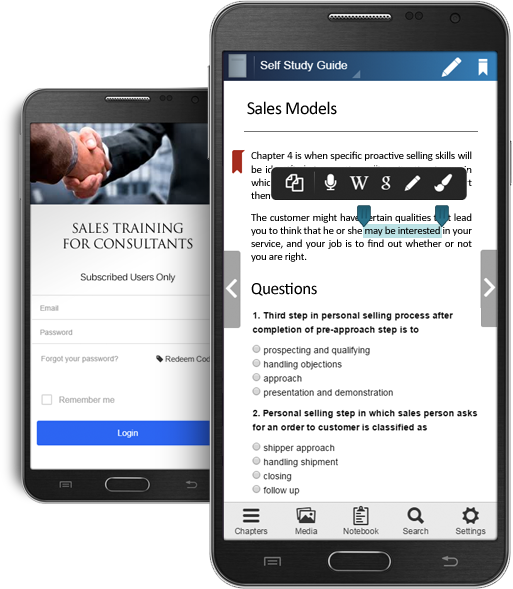
If you remember, earlier we talked about the importance of tracking user data. This is done so you can always reassess your material. A massive advantage in Kotobee Cloud, Library and Author is that you can integrate your ebooks with your organisation’s LMS (by exporting as a SCORM package) or you can integrate your ebook with Google Analytics (or both). Either one of those techniques will provide you with a wide array of information regarding all the activity happening on behalf of your learners.
By integrating with your LMS, you’ll have all the information tracked by the learning management system.
Learn more about integrating your publication with your LMS by reading this support article: Integrating with an LMS
By integrating with Google Analytics, you’ll be able to know:
- The date/time that a certain title was opened
- The name of the chapter that was navigated to
- Any video that has been clicked for playing
- Any audio component that has been clicked for playing
- Any interacted image that has been clicked for animating
- Any image that has been clicked to open in a media panel
- Any book widget that has been opened
- Any self-assessment question component that was solved, along with the user’s answer report
You can learn more about ebook analytics from this support article: Viewing ebook analytics using Google Analytics
For more information about Kotobee’s Cloud ebooks, check out this section of our support blog: Kotobee Cloud

Creating personalized library apps with restricted access
Kotobee Library is designed to cater to institutions and individuals who plan on sustaining a large number of publications. Using Kotobee Library you can create, publish, edit and control access of an unlimited number of publications to an unlimited number of users. You can also add, edit or delete books dynamically.
The best part about Kotobee Library is that it can also be exported as a native mobile app. That way, it can be downloaded through Apple and Google’s App and Play stores, respectively. The library would operate as a fully customizeable and branded platform to hold all your publications in one place, inside your learners’ phones.
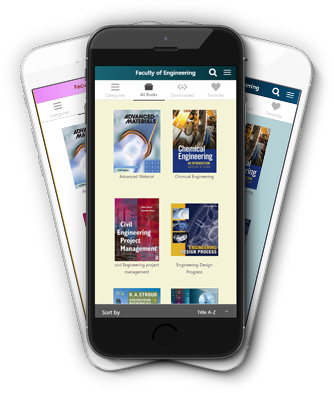
Another advantage of publishing through Kotobee Library is that you can limit restriction to some or all of your ebooks, to all or some of your users. An example would be showing question books to students, while showing answer books exclusively to teachers. You can determine how people can gain access, whether through signing up or by purchasing access or by manual addition by an administrator (this can be done by importing large lists of users).
Offline support is an important feature supported by Kotobee Library. This allows learners to always have access to your platform without needing an internet connection. By creating an offline mobile learning platform, you’d be drastically increasing your platform’s usability. As learners would only need to connect to the internet once to initially download it, they wouldn’t have to live with the extra hassle of being constantly online in order to access your platfrom.
You can learn more about our Library solution by reading this section from our support blog: Managing your Library
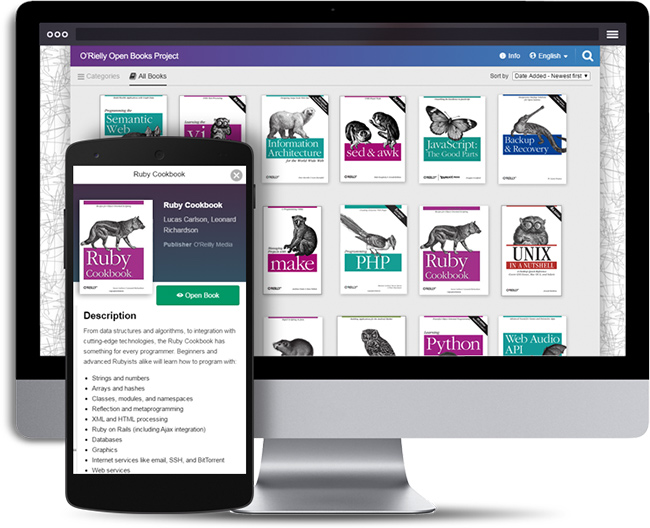
Well, we hope we covered everything you need to start creating awesomely engaging and interactive mobile learning platforms. If you enjoyed it, make sure to bookmark this page for future reference. Also, let us know what you think we could add to make this guide truly inclusive.
You might also like:
How to create an interactive ebook: a step-by-step guide
5 Hacks for Creating a More Engaging Ebook
The Amazing World of Elearning [Infographic]
















Tiago Soriano
May 26, 2017Good article for those who wants to know how it works a mobile learning platform or even develop it.
Kotobee
June 7, 2017Glad you enjoyed it, Tiago. When people hear “mobile learning platform”, it may sound rather grand. But really, it is what you design it to be; it can be as small as a single ebook/app hosted online and you can build you’re way up from there, constantly integrating your smaller tools and initiatives together to create a sizable platform.
vereanngrace
August 24, 2021I have developed one learning material using kotobee author and it was amazingly good. I still have to explore ore on it. Though not yet finished, we will starts using the e-module in our 1st week reading intervention program. Now, I am including it in my research study.